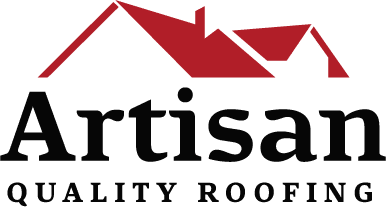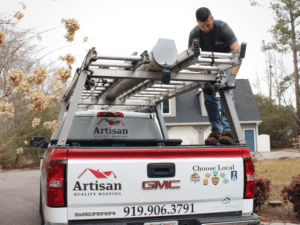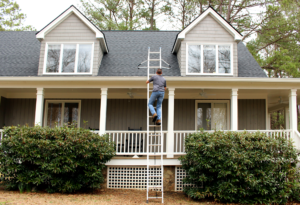
Roof decking is an essential component of any roofing system and is crucial in supporting the weight of your home’s roof. A roof’s decking provides a stable base for the entire roof system. Proper installation, maintenance, and repair of roof decking are critical to ensuring a long-lasting, sturdy roof that can withstand harsh outdoor elements. By understanding the importance of roof decking and taking the necessary steps to maintain and repair it, you can help ensure the integrity and longevity of your roof.
At Artisan Quality Roofing, our experts in roof deck installation have provided the ultimate guide to roof decking in our efforts to help local Raleigh, NC, and surrounding area homeowners keep their roofing materials in the best possible shape to protect themselves and their homes.
What is a Roof Deck?
A roof deck is a layer of material that is installed over the roof’s framing to provide a flat, level surface for the roofing materials to be applied to. It serves as a structural foundation for the roof and supports the weight of the roof and any additional loads such as snow or wind. Roof decking also helps to create a rigid, stable platform for roofers to work on during the installation process.
Benefits of Roof Decking
Here are some of the key benefits of roof decking:
- Strength and stability: Roof decking provides a solid, stable foundation for the roofing structure, providing a base for other roofing materials and helping to distribute the weight of the roof and any additional loads evenly.
- Enhanced structural support: By creating a rigid, stable platform, roof decking helps to support the structure of the roof and prevent it and other roofing components from sagging or collapsing over time. These structural components are essential to avoiding costly roof repairs or a full roof replacement.
- Protection from the elements: Roof decking acts as a barrier against excess moisture, wind, and a potentially damaging weather event that may damage the roof and cause leaks or other issues that need to be replaced.
- Improved insulation: Properly installed roof decking can help improve the energy efficiency of a building by providing an additional layer of insulation that helps to keep the building warm in the winter and cool in the summer.
- Ease of installation: Roof decking is relatively easy to install and can be done quickly and efficiently, making it a cost-effective option for commercial building owners and residential buildings alike.
- Versatility: Roof decking materials can come from a variety of different roofing material options, including CDX plywood, oriented strand board (OSB), wood, and metal. Roof decking is a versatile option that can be customized to suit the specific needs of any home or building.
Overall, roof decking is one of the essential components of a roofing system, providing several benefits that help to ensure the longevity, durability, and structural integrity of your home’s or business’s new roof.
Roof Underlayment vs Roof Decking
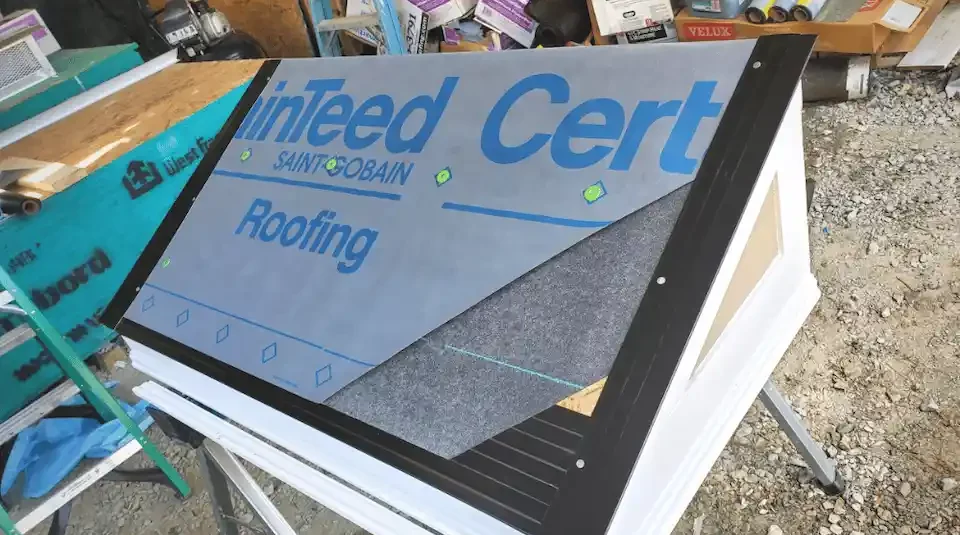
Roof underlayment refers to the layer of material that is installed over the roof decking to provide a moisture barrier and additional support for the roofing materials. Roof underlayment is typically made from materials such as asphalt-saturated felt, synthetic underlayment, or a self-adhering membrane. The purpose of the roof underlayment is to protect the roof decking from moisture and other damage and to provide a smooth and even surface for the roofing materials to be applied.
While roof decking and roof underlayment serve different functions, they are both essential components of a roofing system. Proper installation of both the roof decking and roof underlayment is essential to ensure that the roofing system is structurally sound and water-resistant, and provides the necessary support and protection for the roofing materials.
It’s essential to contact a local roofing company if you suspect you may need to repair or replace your roof. Professional roofing contractors have experience in both roof decking and roof sheathing and can ensure that your roofing system meets all relevant building codes and standards and is installed properly.
Types of Roof Decking

The type of material used for roof decking can have an impact on the overall durability, longevity, and performance of the roof. Different roof decking materials will perform differently in protecting your home, but all types of roof decking are effective as a functioning part of the entire roof system. Hiring a roofing contractor who is an expert at roofing materials and roof deck installation can help determine the best roof decking type for your building or home.
Plywood Roof Decking
Plywood is made from thin layers of wood veneer plank decking that are glued together, creating a strong, durable, and lightweight material. Plywood is available in a range of grades, from high-quality panels with a smooth surface to lower-grade panels with visible knots and other imperfections. Plywood is also a popular choice for roof decking because of its strength, durability, and versatility.
CDX Plywood Roof Decking
CDX plywood is a type of plywood that is commonly used for roof decks but differs in some ways from regular plywood. The term “CDX” stands for “C-D Exposure 1,” which indicates that the plywood has a C-grade front veneer and a D-grade back veneer, and is designed for use in applications where it will be exposed to some moisture but not directly exposed to the elements. When considering roof decking cost, CDX plywood roof decking is an affordable, durable, and versatile option that is commonly used in residential and commercial roofing applications.
CDX plywood roof decking is made from thin layers of wood veneer that are glued together. The CDX plywood is available in a range of thicknesses, from 1/4 inch to 3/4 inch, and can be cut to size and shape to fit virtually any roof configuration. The panels are typically installed over the roof’s framing and provide a flat, level surface for the roofing materials to be applied to.
OSB Roof Decking
OSB (Oriented Strand Board) is a type of roof decking that is commonly used in residential and commercial roofing applications. It is a cost-effective and durable alternative to plywood roof decking. OSB is made by compressing and gluing together strands of wood planks, which are arranged in alternating layers to create a strong, durable panel. OSB roof decking is available in a range of thicknesses and grades, making it a versatile option that can be customized to suit the specific needs of the building.
Metal Roof Decking
Metal roof decking is a type of roofing material that is commonly used in commercial and industrial roofing applications. A roof decking material typically made from steel or aluminum, metal roof decking is known for its strength, durability, and fire resistance. Metal roof decking is available in a range of thicknesses, profiles, and finishes, making it a versatile option that can be customized to suit the specific needs of the building. It is commonly used in flat or low-slope roofing systems and can be installed over a variety of substrates, including wood, concrete, and steel.
What is Rotten Decking on a Roof?
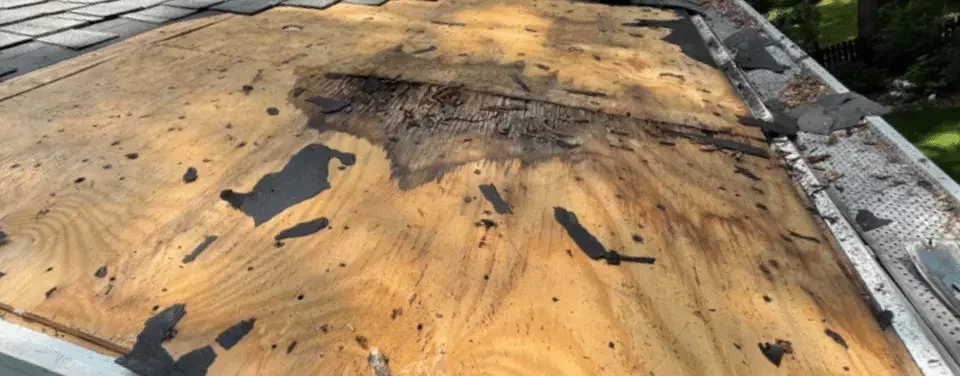
Roof deck and roof sheathing rotting can be a serious issue for a roofing system. Rotting can occur when moisture is able to penetrate the roof decking or roof sheathing and is not properly ventilated or dried out. If the roof decking or roof sheathing becomes saturated with moisture, it can begin to rot and deteriorate over time. This can compromise the structural integrity of the roof and can also lead to damage to the roofing materials and other components of the roofing system.
Some common causes of the roof deck and roof sheathing rotting include:
- Poor ventilation
- Leaks
- Condensation
- Exposure to the elements
Signs of Rotted Roof Decking
Here are some common signs of roof decking rot:
- Sagging or dipping sections of the roof
- Soft or spongy feeling when walking on the roof
- Discoloration or dark spots on the roof decking
- Moisture or water stains on the ceiling or walls inside the building
- Roof leaks or water infiltration
- Cracks or splits in the roof decking
- Visible mold or mildew growth on the roof decking
- Roofing materials that appear loose or unstable
If you notice any of these signs of roof decking rot, it is important to address the issue as soon as possible to prevent further damage to the roofing system and the building itself. Working with a professional roofing contractor with experience in addressing roof decking rot is essential to ensure the issue is properly identified and undergoes roof repairs. Regular roof inspections and maintenance can also help reduce the risk of roof deck rot.
Maintenance and Repair of Roof Decking
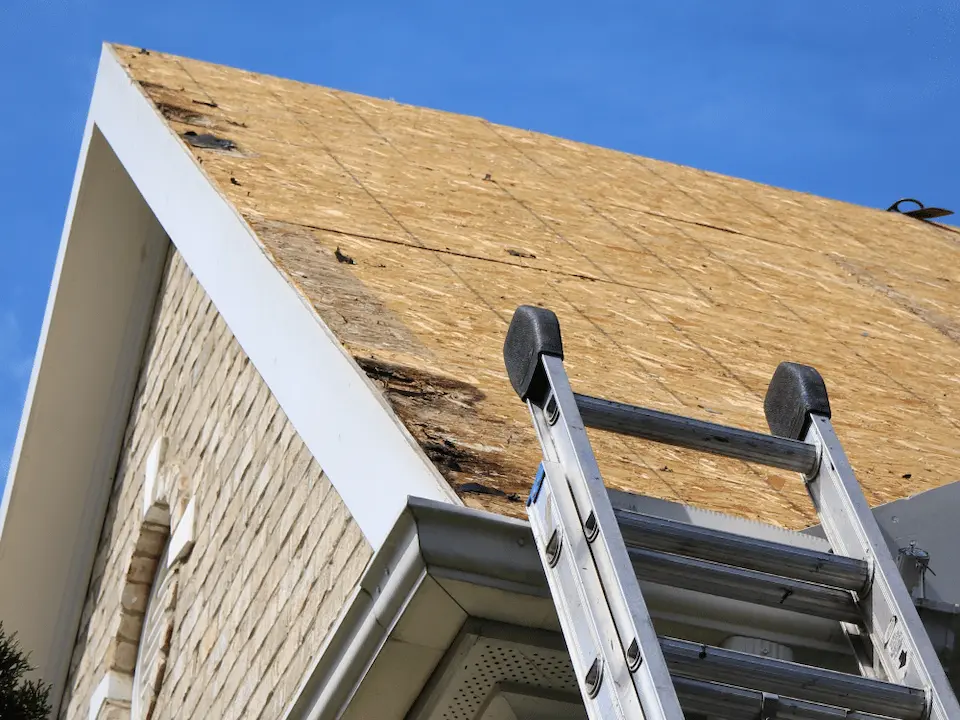
Regular roof maintenance and roof inspection of roof decking can help prolong its life and prevent issues from arising. Checking for signs of damage, ensuring proper ventilation, and addressing any issues promptly can help prevent costly repairs or replacements. If roof decking becomes damaged or deteriorated, it should be repaired or replaced as soon as possible to prevent further damage to the roof.
Contact a Raleigh Roof Decking Contractor Today!
Have you been experiencing signs that your roof decking may be in need of repairs or a replacement? Artisan Quality Roofing serves homeowners and commercial building owners in Raleigh, NC, and surrounding areas for your roofing needs.
To schedule a roof decking and roofing materials inspection today, call our roof deck repairs contractors at 919-906-3791 or fill out the contact form below to get started.
